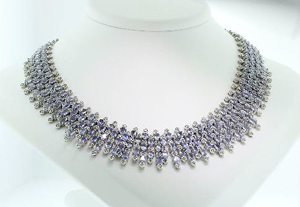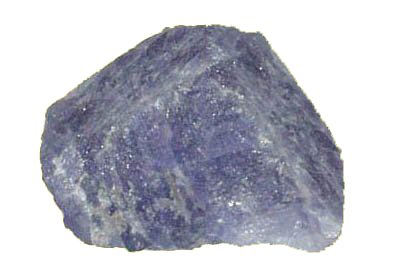
THOUSAND OAKS, Calif. – The natural art of Africa is seen not only in its breathtaking landscape but also in its mineral deposits that yield the exotic gemstones so sought after in today’s marketplace. Among those coveted minerals is the tanzanite, as seen in the glittering tanzanite/diamond necklace that is expected to finish among the top lots in Seized Assets Auctioneers’ June 20 sale.
A professional gemologist has appraised the necklace at the high-estimate figure of $50,200, and the appraisal report will be provided to the winning bidder who purchases the lot.
Tanzanite is the blue/purple variety of the mineral zoisite, first discovered in 1967 near the city of Arusha. Found mostly in the foothills of Mount Kilimanjaro, tanzanite is a rare gem noted for its remarkably strong trichroism, appearing alternately sapphire blue, violet, and burgundy depending on crystal orientation.
In its rough state, tanzanite is usually a reddish brown color. It requires artificial heat treatment to 600 degrees Celsius in a gemological oven to bring out the blue/violet of the stone.
Manuel D’Souza, a Goan tailor and part-time gold prospector living in Arusha found transparent fragments of vivid blue and blue/purple gem crystals on a ridge near Mererani, some 40 km southeast of Arusha. He decided that the mineral was olivine peridot but quickly realized that it was not, so he took to calling it “dumortierite,” a blue non-gem mineral.
Shortly thereafter, D’Souza showed the stones to John Saul, a Nairobi-based consulting geologist and gemstone wholesaler who was then mining aquamarine in the region around Mount Kenya. Saul, with a Ph.D. from MIT – who later discovered the famous ruby deposits in the Tsavo area of Kenya – eliminated dumortierite and cordierite as possible I.D.s and sent samples to his father, Hyman Saul, vice president at Saks Fifth Avenue in New York.
Hyman Saul carried the samples across the street to the Gemological Institute of America, where they were accurately identified as a variety of the mineral zoisite. Correct identification was also made by mineralogists at Harvard, the British Museum, and Heidelberg University, but the first person to get the identification right was Ian McCloud, a Tanzanian government geologist based in Dodoma.
From 1967 to 1972, an estimated 2 million carats of tanzanite were mined in Tanzania. The mines were later nationalized by the Tanzanian government. Tanzanites were first marketed on a retail basis in the United States in 1969, by Tiffany’s, who presented the exclusive gemstone to the general public with a broad-based advertising campaign.
View the tanzanite/diamond necklace in the fully illustrated catalog for Seized Assets Auctioneers’ June 20 sale and sign up to bid absentee or live via the Internet on auction day at www.LiveAuctioneers.com.
ADDITIONAL IMAGE OF NOTE


